The End of Ethereum? Why ETH May Be Facing an Impossible Battle

Ethereum is lost. There, I said it.
Right now, it feels like Ethereum is scrambling to stay relevant, with no clear direction, and the cracks are definitely starting to show. It’s kinda like watching the once-great champion of the blockchain world slowly get outpaced by newer, faster contenders. And the sad part? It’s staring Vitalik and the Ethereum community in the face — but they’re still trying to convince themselves, and everyone else, that everything’s fine.
Spoiler alert: it’s not.
I’m going to lay it all out for you and at times it may seem a little technical but I’ll break it down and I promise it will be worth your time so make sure to keep reading!
Centralization: Is Ethereum Really Decentralized Anymore?Here’s a question we need to ask: Is Ethereum really decentralized? Sure, Ethereum is praised for its decentralization and security, but a recent study reveals something alarming — three block builders now produce over 90% of the blocks on Ethereum. Yep, just three players dominate Ethereum’s block production.
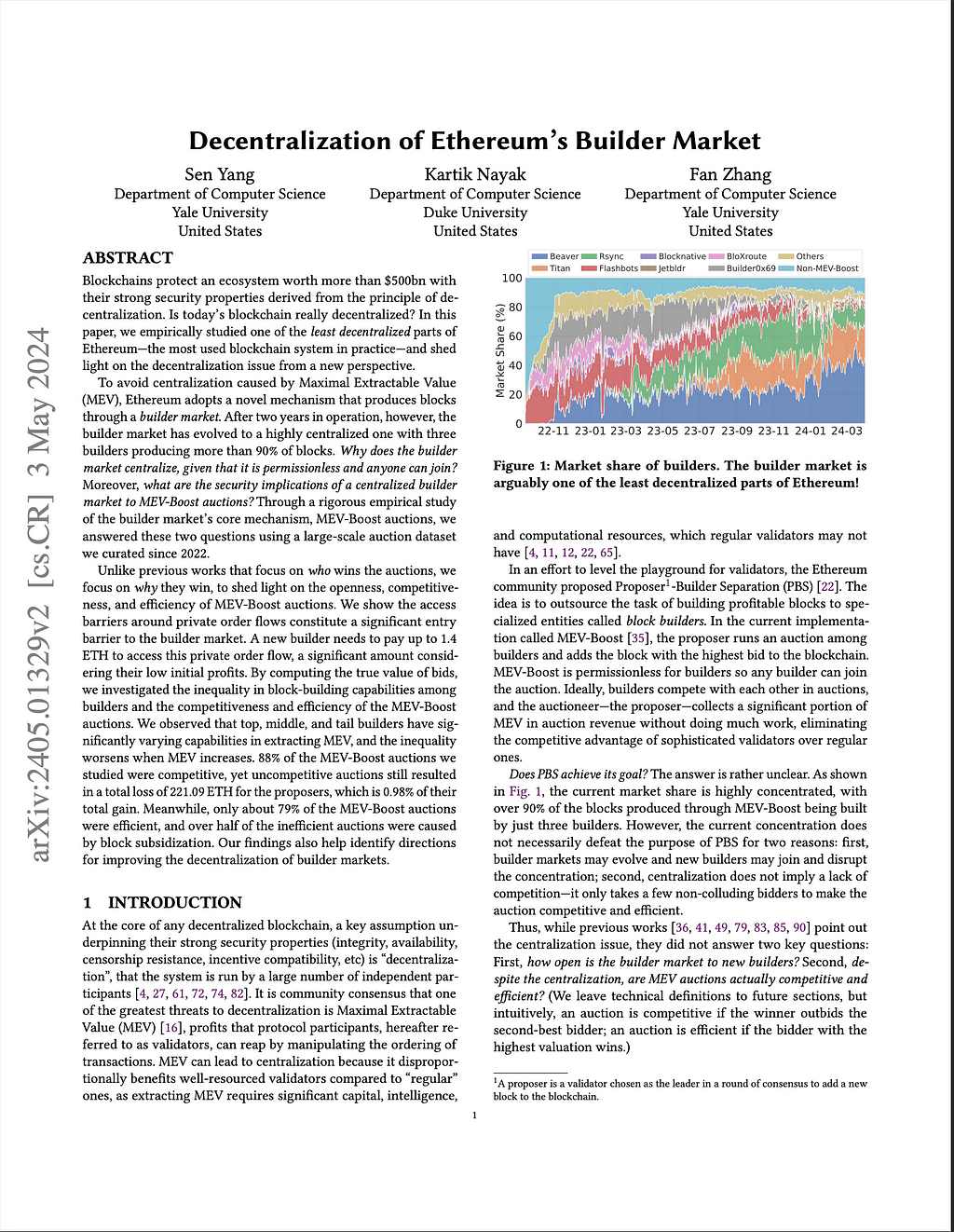 https://drive.google.com/file/d/1YI-3CPW0z7qaaLaXOHIey95lteYqFG7d/view?usp=drive_link
https://drive.google.com/file/d/1YI-3CPW0z7qaaLaXOHIey95lteYqFG7d/view?usp=drive_linkThat’s right — three. In a network that’s supposed to be permissionless and decentralized, this kind of concentration is a huge red flag.
To combat MEV-induced centralization, Ethereum introduced MEV-Boost auctions as part of its builder market mechanism. The idea was to create a more competitive environment and distribute block-building more evenly. But after two years, we’re seeing the opposite: the market has centralized significantly. Instead of leveling the playing field, MEV-Boost has essentially reinforced the dominance of a few players.
And it gets worse. Access to private order flows — where the most lucrative MEV opportunities are found — costs up to 1.4 ETH. That’s a hefty price tag for new builders, especially given their low initial profits. This creates a significant barrier to entry, preventing newcomers from competing with the already established players who are raking in most of the rewards.
Proposer-Builder Separation (PBS): A Band-Aid on a Bigger Problem?Ethereum has tried to address these centralization issues with something called Proposer-Builder Separation (PBS). In simple terms, this mechanism splits the role of proposing blocks (done by validators) from building them (handled by specialized builders). Proposers are validator nodes selected by the network to propose the next block, while builders construct blocks to maximize rewards from transaction fees and MEV opportunities.
Sounds good in theory, right? But in reality, PBS hasn’t fully solved the problem. The same study found that while 88% of MEV-Boost auctions were competitive, but a surprising 12% were not. And even when competition exists, it’s not always efficient — only 79% of the auctions are considered efficient. The inefficiencies are mostly due to block subsidization, where some builders effectively pay to win, distorting the market.
So, despite Ethereum’s best efforts, block-building is still highly centralized, and PBS isn’t the silver bullet it was hoped to be. Instead, it’s just another band-aid on a deeper wound.
The Shared Sequencer Debate: A Losing Battle?Now here is where the Ethereum community is split. Let’s just lay it out: on one side, you’ve got Justin Drake, Ethereum Researcher, and others pushing for something called shared sequencing. Now, this might sound fancy, but it’s really an almost impossible task. Why? Because it requires getting all the Layer 2 solutions to coordinate, with very little incentive to do so. Sure, the main benefit is synchronous composability, meaning everything can work together at the same time, but the hurdles to get there are massive.
And on the other side, you’ve got Vitalik Buterin — the face of Ethereum — who’s downplaying that very benefit. He doesn’t seem to think synchronous composability is that big of a deal as you can see here. And honestly, I agree with him. So do many others in the space.
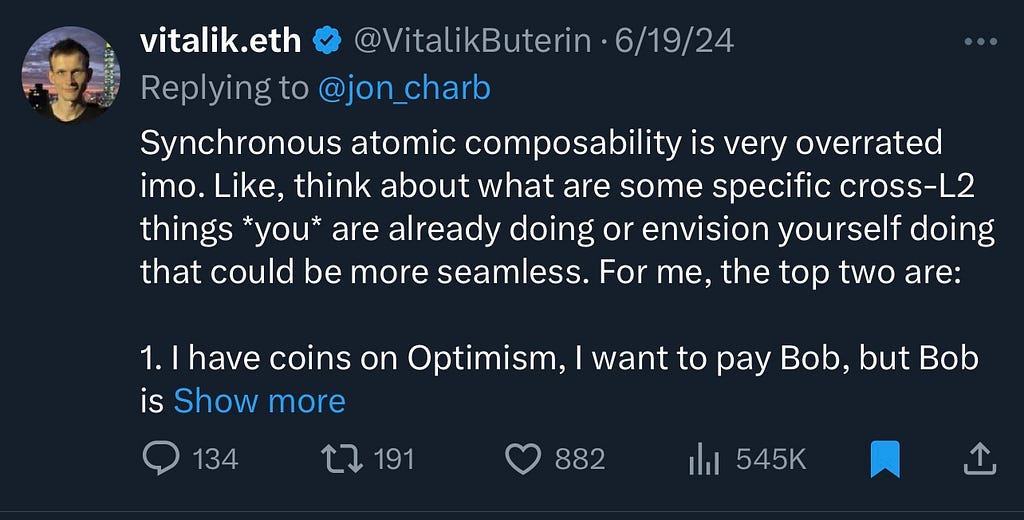 https://x.com/vitalikbuterin/status/1803459217933623418?s=46&t=OWWPk2bYT63xTNLVjVXe7Q
https://x.com/vitalikbuterin/status/1803459217933623418?s=46&t=OWWPk2bYT63xTNLVjVXe7QBut here’s where things get interesting: asynchronous composability — the alternative — is actually just as good. You get similar guarantees and a great user experience, while being able to maintain atomicity (everything happens all at once or not at all) with a little know-how. Plus, the concerns about developer experience (devX) are blown out of proportion. Better tooling is already minimizing these concerns.
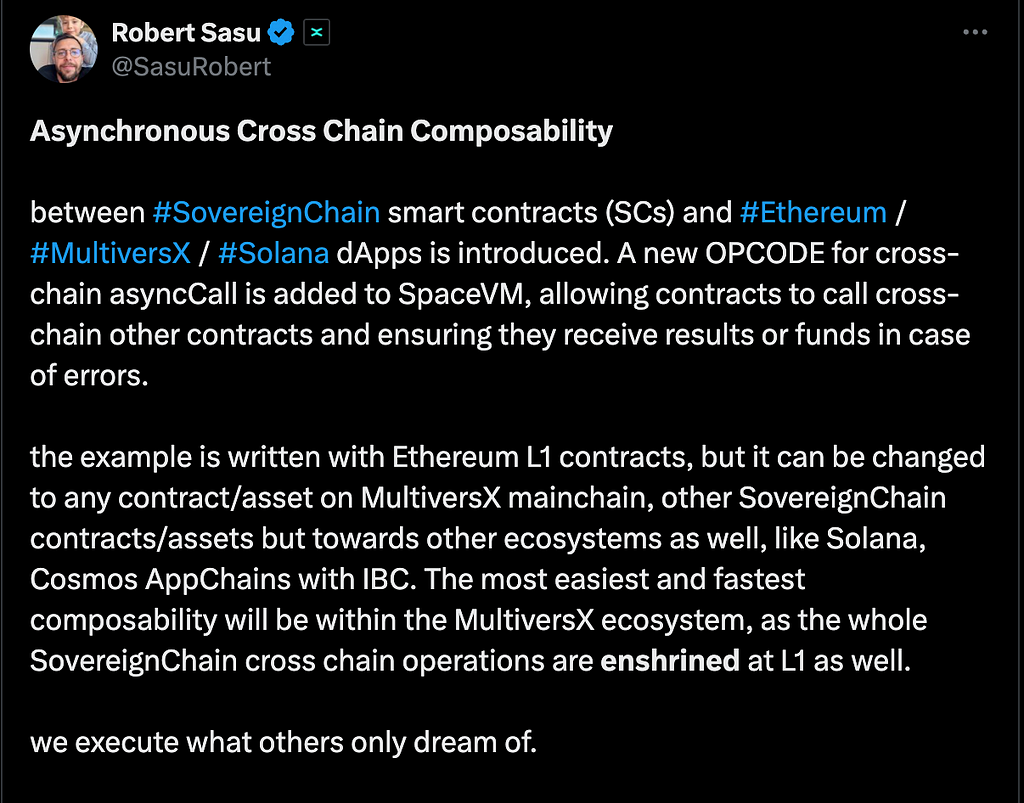 https://x.com/sasurobert/status/1796471251122147794?s=46&t=OWWPk2bYT63xTNLVjVXe7QLook at MultiversX: A Better Way Forward
https://x.com/sasurobert/status/1796471251122147794?s=46&t=OWWPk2bYT63xTNLVjVXe7QLook at MultiversX: A Better Way ForwardWhile Ethereum is struggling with these issues, other chains like MultiversX are showing a different path forward. They’ve implemented a sharded architecture that addresses these problems at the protocol level. Ethereum is trying to push the responsibility onto wallets and dApps, which is like putting a Band-Aid on a broken bone.
Let me ask you something — ever have your internet go out? You call your provider, spend an hour troubleshooting, and in the end, they blame it on your router. So you call the router company, sit through another hour of tech support, and they tell you it’s an issue with your internet provider. Yeah, that’s kind of what’s happening in the Ethereum ecosystem right now. Everyone’s passing the buck, trying to avoid taking responsibility for Ethereum’s inefficiencies.
Vitalik Knows the Truth, But Can Ethereum Keep Up?The sad reality is that Vitalik and the Ethereum community are well aware of the challenges they face, yet often fail to acknowledge the amazing innovation happening elsewhere. Still sinking countless hours and days trying to convince people that Ethereum can keep up with the evolution of Web3. But deep down, we all know it can’t. And don’t get me wrong — I have immense respect for Vitalik. He’s a visionary, and Ethereum paved the way for the incredible innovations we see today.
But here’s the thing: the innovations have surpassed Ethereum’s potential. We’re talking about more efficient virtual machines (VMs), more secure and composable asset structures, and even fully sharded Proof-of-Stake (PoS) systems that can scale to millions of transactions per second — all without sacrificing security or decentralization.
So Vitalik’s dream? It’s no longer just a dream. It’s here. It’s live. And it’s functioning today, achieving the milestones Ethereum hoped to hit with ETH 2.0.
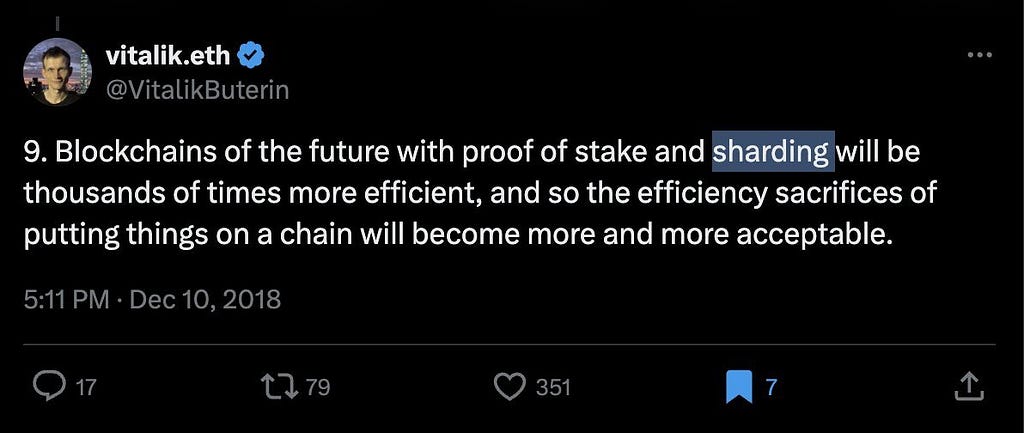 https://x.com/vitalikbuterin/status/1072162014498148355?s=46&t=OWWPk2bYT63xTNLVjVXe7QEthereum’s Lose-Lose Situation
https://x.com/vitalikbuterin/status/1072162014498148355?s=46&t=OWWPk2bYT63xTNLVjVXe7QEthereum’s Lose-Lose SituationSo, where does this leave Ethereum? Stuck in a lose-lose situation pretty much. With a couple options on how to move forward, but none are really all that ideal.
Option 1: Ethereum can keep hoping that everyone will play nice and that shared sequencing or builder markets will work out. But let’s be real — that’s not going to happen. It’s the “trust me, bro” approach, and it comes with a host of challenges.
One I haven’t even mentioned yet? Trying to maintain credible neutrality. While you’ve got half a dozen shared sequencer protocols being built currently, many prefer to stick to using Ethereum as the base layer. This is referred to as Based rollups and also comes with many limitations and issues.
Option 2: Go back to the original roadmap of sharding or enshrined rollups. These two ideas are similar in that they both aim to solve Ethereum’s scaling issues by increasing security, scalability, and composability. But here’s the kicker — Vitalik himself wasn’t convinced that sharding would work. Why? Because of the inefficiencies in the ERC token model.
MultiversX Shows the Way ForwardThis is where MultiversX comes back into the picture. They’ve solved the sharding issue by using an asset-oriented token model. In simple terms, this means your tokens are actually in your possession, unlike on Ethereum, where assets are just data in a shared smart contract. Ethereum’s model? It’s inefficient and even insecure, which is why we see so many hacks and wallet drains on EVM chains.
I don’t want to get too deep into the weeds here, but if you’re curious about how this works, I’ve got more content on that you can find here. For now, let’s just say that Ethereum’s path forward is anything but easy.
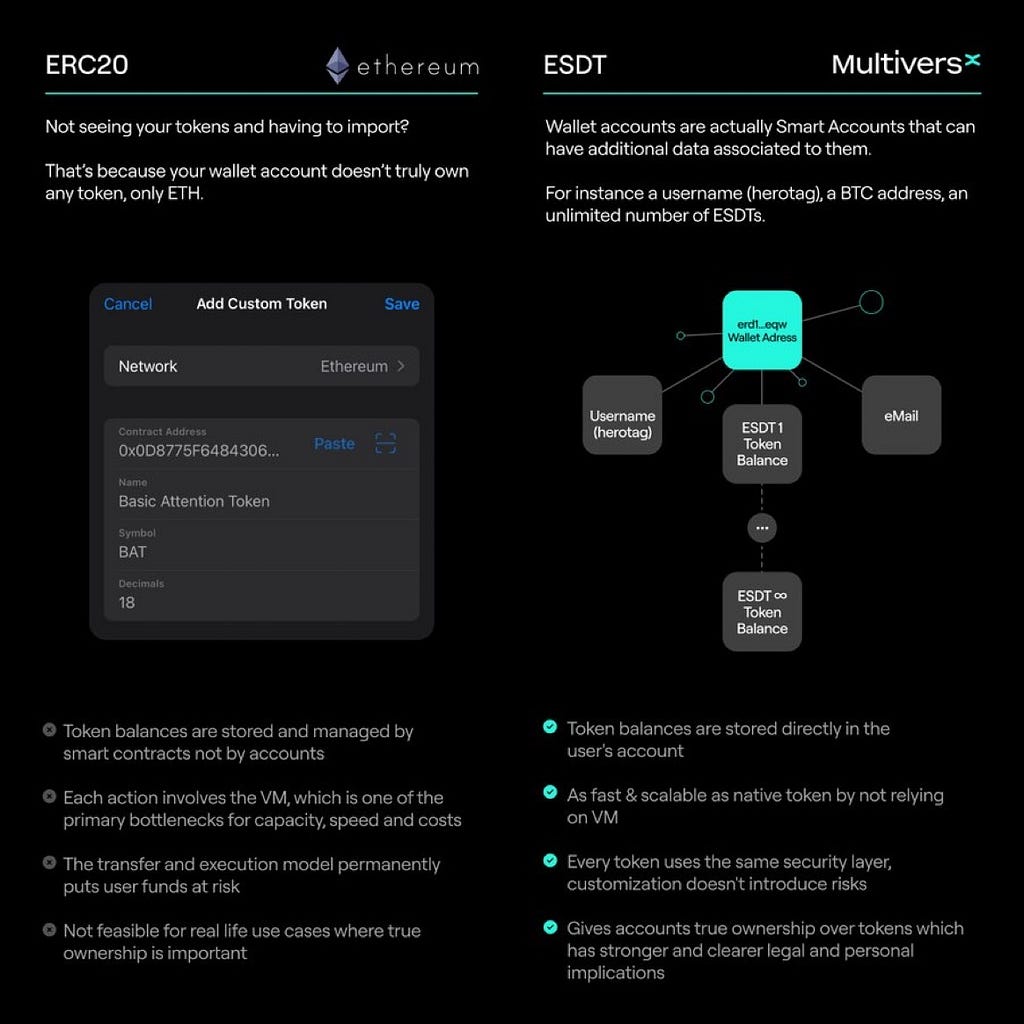 The Layer 2 Dilemma: A Growing Market with Major Flaws
The Layer 2 Dilemma: A Growing Market with Major FlawsNow let’s not forget about the Layer 2 market. It’s growing fast, but not for the right reasons. If Ethereum decides to move forward with major Layer 1 protocol changes, it could make many Layer 2 solutions pointless. And that’s a market that’s booming right now — whether or not it’s actually solving the underlying issues.
The irony here cannot be missed. We’re seeing a surge in Layer 2 adoption, not because they’re the ultimate solution, but because they’re a temporary band-aid for Ethereum’s scalability issues. These Layer 2s are essentially profiting off Ethereum’s shortcomings, creating a whole new set of problems in the process. Centralization risks, security vulnerabilities, and the potential for user funds to be compromised are just the tip of the iceberg. Yet, the hype train keeps rolling, with promises of a decentralized future that seems forever out of reach.
And let’s be real, the moment Ethereum’s base layer evolves to address these issues, the Layer 2 landscape could crumble like a house of cards. All those projects that raised millions on the premise of being the next big thing? They might just find themselves obsolete overnight. It’s a risky game, and the stakes are higher than ever.
The zkEVM Hail MaryThere is still one more hope left for Ethereum: zk proofs. Not zk-rollups, but a fully integrated zkEVM. Sounds great, right? Except there’s one problem — it’s not ready yet, and it won’t be for at least five years. And even then, it requires massive computing power to run effectively.
So, what does this mean? Ethereum is essentially backed into a corner, with no good options left on the table. And while the Ethereum community might not want to admit it, this is why we’re seeing so much turmoil right now, along with a steady decline in ETH’s value and dominance.
The Parasitic Rollup ModelLet’s talk about the elephant in the room: Ethereum’s current rollup model is parasitic to the base layer. Over the last six months, Ethereum has become inflationary, and L2s are keeping over 95% of the value generated. Only a tiny fraction is trickling back down to the base layer — ETH. That’s what I would call a broken model!
Oh, and don’t even get me started on how all these rollups are entirely centralized and can steal users funds at any time. At least they all promise to work towards a decentralized future…with fingers crossed behind their backs and a quiet whisper of “trust me, bro”.
 It’s Time to Move On
It’s Time to Move OnSo Here’s the harsh reality: it’s time to move on. Web3 is evolving at breakneck speeds, and Ethereum is being left behind. No amount of Ethereum Improvement Proposals (EIPs), middleware, or protocol upgrades can fix a weak foundation. You can’t build a 100-story skyscraper on a plot of land that can’t support it. And you can’t keep adding layers and band-aid fixes to a blockchain with structural issues.
Many in the space already understand this. Instead of trying to fix Ethereum’s broken foundation, they’re focused on building stronger foundations from the ground up. They’re delivering solutions that offer a 10–100x improvement in nearly every aspect. This is the kind of 0 to 1 innovation that Ethereum just can’t keep up with anymore.
The Future Is InevitableLook, technology evolves. It’s inevitable. And yes, Ethereum is technology. Just as we moved from dial-up to broadband, from mail to email, and from cable to streaming, we’re now moving from Gen 1 blockchains to Gen 2/3 and beyond.
The future is coming faster than anyone expected, and Ethereum isn’t part of it.
The End of Ethereum? Why ETH May Be Facing an Impossible Battle was originally published in Coinmonks on Medium, where people are continuing the conversation by highlighting and responding to this story.
